Introduction
Adolescence is a period of rapid growth and development bridging childhood and adulthood.1 Practising healthy eating behaviours is one of the most important factors to meet the nutritional needs of adolescents and proper eating behaviours that are learned in early life are maintained in adulthood thus reduces the risk for major chronic disease.2,3 Physical and psychological changes occurring during this period usually significantly influence their dietary behaviours.1,4 As teens become more independent, they make more of their own food choices. Nevertheless, being influenced by a multitude of factors (biological, social, physical, economic, psychosocial, attitudes, beliefs and knowledge about food) and changing of lifestyle may affect their dietary choices and eating behaviours, thus making them fail to adhere to healthy eating practices.5,6
Meal skipping is a common behaviour among adolescents. Meal skipping increases throughout adolescence as teens try to sleep longer in response to early school start times, try to lose weight through calorie restriction, and their lives become busier in general.7 Breakfast is the most commonly skipped meal, especially among female adolescents.8 Breakfast skipping has been associated with poor health outcomes including higher body mass index (BMI), poorer concentration and school performance, and increased risk of inadequate nutrient intake, especially calcium and fibre.9,10
Snacking is a common feature of the diet of adolescents. Unfortunately, food choices made by adolescents while snacking tend to be high in sugar, sodium and fat, while relatively low in vitamins and minerals.11 Indeed, there is evidence from local studies that adolescents are consuming too many unhealthy snacks such as crisps, chocolates, sweets, and sugared fizzy drinks and are not consuming enough fruits and vegetables.12,13 In addition, fast food options such as pizzas, fried chicken, burgers, and hot dogs are gaining popularity among adolescents, possibly because of their taste, convenience and the influence of peers.14
Over the past few decades, Mauritius has undergone significant economic progress. This has led to considerable changes in the lifestyle of Mauritians so much so that Mauritius has one of the highest rates of diet-related non-communicable diseases such as obesity, diabetes and cardiovascular diseases in the world.15 This change in lifestyle is impacting on the health of our youth as shown by the National Plan of Action for Nutrition (2009-2010) which revealed that the prevalence of overweight and obese adolescents, aged 12-19 years, is 8.4% and 7.3%, respectively.16 As a result, the Ministry of Education and Human Resources in collaboration with the Ministry of Health and Quality of life has prohibited the sale of soft drinks and unhealthy snacks in school canteens.
The health and nutrition status of adolescents warrants particular attention, since these young people are the future generation of the country. In light of these findings, the present study was undertaken to evaluate and understand eating behaviours of secondary school adolescents in a multicultural and developing Island like Mauritius. The specific objectives of the study were mainly geared towards assessing Mauritian adolescents’ eating behaviours, delineate their nutritional knowledge and correlate it with their eating behaviours. We also endeavoured to determine whether eating behaviours of adolescents have improved and are associated with key socio-demographic factors.
Findings from this study would be beneficial for designing and evaluating health- and nutrition-promotion strategies that are appropriately targeted, as well as providing useful data for the development of further research examining the relationship between health and nutrition-related attitudes and dietary habits among adolescents.
Materials and Methods
Study design, subjects and sampling
This study was reviewed and approved by the ethics committee, Department of Health Sciences, University of Mauritius. The study focused on school adolescent (mainly from secondary schools). A list of all registered secondary schools was first obtained from the Ministry of Education and Human Resources. Schools were categorised as rural and urban. Eight schools were then chosen randomly from each category. In each school, one class (Form I to Upper VI) were randomly selected. Approval of the school principals was obtained before the start of the study and written informed consent was obtained from their respective parents. Based on Krejcie and Morgan17 statistical table for determining sample size, for a given population of 164,278 Mauritian adolescents, the required sample size was 384 for ±5% precision with 95% CL (confidence level) and p = 0.5 (degree of variability).18 The final study sample consisted of 384 adolescents (190 males and 194 females), 12-19 years old.
Measuring instrument – Questionnaire
In this research, Mauritian adolescents have been interviewed by means of a written questionnaire. The questionnaire was carefully developed and adapted based on existing validated questionnaires19,20 and from previous literature2,8 on eating behaviours of adolescents. Close-ended questions were used except for those which contained the ‘Other (please specify)’ option. The questionnaire consisted of 18 questions and was divided into five main sections:
SECTION A – Demographics: Contained information on personal data which included age, gender, average family income in rupees per month and geographical location. Demographic questions were included in order to characterise the adolescents in the study.
SECTION B – Meal: This section was designed to assess the frequency of meal consumption in particular related to breakfast, type of foods and beverages consumed for meals as well as the daily consumption of fruits and vegetables.
SECTION C – Fast food consumption: This section dealt with the frequency of fast food intake among teens. Fast food was defined as foods high in fat and salt, and low in dietary fibre such as fried noodles/rice, fried chicken, hamburgers, pizzas or ‘dholl puri/roti’.
SECTION D – Snacking behaviour: Snacking was defined as the consumption of foods and drinks between meals. This section assessed the contexts in which adolescents snacked, reasons for snacking and the type of snack foods and beverages consumed. From Table IV, fruits, yogurt, nuts and pudding were classified as healthy snacks while the rest as unhealthy snacks in a view to determine whether adolescents were consuming healthy (or unhealthy) snacks.
SECTION E – Nutritional knowledge: This part focused on key nutritional aspects, investigating the level of knowledge that adolescents have in this area. Nutritional knowledge was assessed in a view to determine whether adolescents have a good knowledge about healthy foods and eating behaviours, and most importantly, whether this knowledge is translated into healthy eating behaviours.
Pilot Testing
The questionnaire was pre-tested among a group of secondary school adolescents (n= 10) of the same age group. Potential problems and ambiguity with the questionnaire were identified and resolved before the study began. The wording for a few questions was changed for simplicity and to remove ambiguity. After adjustments, the final version of the questionnaire was then self-administered to respondents.
Data Collection
The questionnaire was self-administered. Students filled in the questionnaires during regular class times, and questionnaires were also collected in class. All questionnaire data was checked and verified. Data were collected during the academic year 2010-2011. The language used for this study was English.
Statistical Analysis
SPSS 16.0 was used to compute all relevant descriptive statistics and test hypotheses as well. One noteworthy point is the calculation of a ‘popularity’ score (or weighted mean), explained below, in order to compare the ‘popularity’ of food items consumed among adolescents.
From Table II, the (‘Always’, ‘Often’, ‘Sometimes’, ‘Never’) scale was considered as being a 4-point Likert scale, which, by definition, is ordinal in nature but may be treated as interval, on the assumption that the gaps between its options (values) are equal (a common practice by most of today’s researchers).
On an interval scale, options may be assigned numerical values so that a weighted mean can be calculated. From Table II, the following assignments were made:
4 = ‘Always’ 3 = ‘Often’ 2 = ‘Sometimes’ 1 = ‘Never’
‘Always’ was assigned the highest value because it reflected the highest frequency of consumption (of food), ‘Often’ was next highest and so on.
Using a table of frequencies (instead of percentages as in Table II), the scores in the last column are actually weighted means based on frequency of consumption. The more people consume a certain item, the more popular it is. Hence, this weighted mean has been sensibly called a ‘popularity score’ for the purpose of this research.
For example, the weighted mean (or popularity index) for ‘breakfast cereals’, from Table II, has been computed as follows:

where a, b, c and d were the observed frequencies for ‘Always’, ‘Often’, ‘Sometimes’ and ‘Never’ respectively.
The same principle was used to calculate the ‘popularity’ score, as shown in Tables III and IV.
In terms of inferential statistics, the Chi-square test of independence was performed to determine association between socio-demographic factors and eating behaviours, whereby a statistical probability level of p < 0.05 (5%) was considered as significant, the default SPSS significance level having been set at 0.05. A correlation test (via the Pearson Product-Moment Correlation Coefficient – r) was also performed to determine the relationship between nutritional knowledge and eating behaviours.
Results
Study Participants
Among the 384 adolescent participants (12 – 19 years), more were female (50.5%) than male (49.5%) and more resided in the urban (55.3%) than the rural (44.7%) areas. The average monthly family income (rupees) of 16.1% of the participants was less-than or equal to 10,000, while it ranged from 10,001 to 70,000 for 70.3% of the participants and greater than 70, 000 for the rest (Table 1).
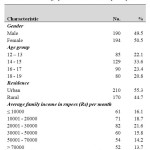 |
Table 1: Demographic characteristics of participants Click here to View table |
Food items and beverages consumed for breakfast
The ‘popularity’ score shows very clearly that respondents preferred eating cereals (2.48) or bread with butter/margarine (2.47). Quite a few participants also included a fruit for breakfast (2.09) (Table 2).
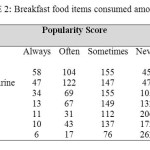 |
Table 2: Breakfast food items consumed among adolescents Click here to View table |
Majority of the adolescents drink tea (51%) followed by milk (42%) at breakfast as compared to fruit juice, water, coffee and chocolate drink (Figure 1).
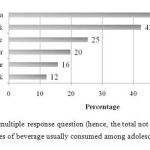 |
Figure 1: Types of beverage usually consumed among adolescents for breakfast Click here to View figure |
Food habits for lunch and dinner
Respondents did like consuming sausages and burgers but mainly in fried form. At lunch, a salad or fruit would be equally welcome (mean scores of 2.48 and 2.37 respectively). Cooked vegetables were very popular for dinner time among most respondents with a high mean of 3.36, very often accompanied by a raw salad with a mean of 2.83 (Table 3).
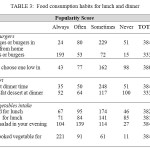 |
Table 3: Food consumption habits for lunch and dinner Click here to View table |
Fast food consumption
As depicted in figure 2, it was found that most of the participants fell into the ‘1 – 3 times a month category’ closely followed by either ‘once a week’ or ‘less than once a month’.
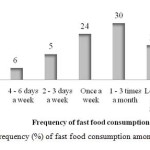 |
Figure 2: Frequency (%) of fast food consumption among adolescents Click here to View figure |
A Chi-square test of independence revealed that the frequency of fast food consumption was significantly higher in adolescents from low-income groups (p = 0.008).
Meal skipping patterns
Figure 3 illustrates the frequency (%) of skipping breakfast among participants, and the frequency (%) of having lunch and dinner among adolescents.
Figure 3 shows that 68% of the participants skipped breakfast, however, with only 6% skipping breakfast always. No significant differences (p > 0.05) were found between socio-demographic variables and breakfast skipping. A similar pattern was observed for lunch and dinner consumption as shown in figure 3, whereby most of the participants always had lunch (84.1%) and dinner (92.4%). It should be noted that none of the participants reported ‘never’ for having lunch and dinner, i.e. participants never skipped lunch and dinner.
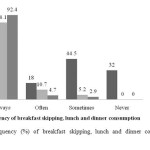 |
Figure 3: Frequency (%) of breakfast skipping, lunch and dinner consumption among adolescents Click here to View figure |
Snacking Behaviour
A very high percentage of adolescents (84%) from this study reported that they consumed snacks in between meals. Incidentally, via a Chi-square test, female adolescents (p = 0.010), urban residents (p = 0.030) and those from low-income families (p = 0.011) were found to be more prone to snacking behaviour.
Fruits and yogurt appear to be the most popular snacks with respective means of 5.57 and 4.55. However, snacks like cakes, pastries, biscuits with cream, savoury snacks, sweets and chocolates follow immediately after in terms of popularity, all with means higher than 4 (out of a possible 7) (Table 4).
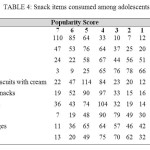 |
Table 4: Snack items consumed among adolescents Click here to View table |
Assigning values of 7 to 1 were assigned to ‘Daily’, ‘4-6 times a week’, ‘2-3 times a week’, ‘Once a week’, ‘1-3 times a month’, less than once a month’ and ‘never’ respectively, a ‘popularity’ score was computed for each snack item as shown in last column.
A strong majority of adolescents drink either water or juice (76% and 52% respectively) between their meals as compared to tea, fizzy or milky drinks as shown in figure IV.
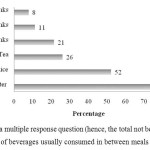 |
Figure 4: Types of beverages usually consumed in between meals among adolescents Click here to View figure |
Nutritional knowledge
The majority of the adolescents (78.9%) do recognise that breakfast is, by far, the most important meal. All the remaining questions yielded a very high percentage of ‘Yes’ as answer (all above 80%), indicating that adolescents were very well aware of the type of food that they should consume or that they were very health-conscious. However, negative correlation coefficients indicate that, despite the fact that adolescents are fully aware that they should reduce their fat intake, they will still not opt for low-fat lunch or dessert (p = -0.147 and p = -0.186 respectively).
The correlation between ‘Keeping sugar consumption down’ and ‘Adding sugar to drink’ was not significant. Nevertheless, a weak and positive correlation indicates that, even though adolescents know that sugar intake should be kept to a minimum, they still add sugar to their drinks (p = 0.160).
Discussion
It is important that adolescents eat three meals per day, with special attention to breakfast, labelled as the most important meal of the day ,21 as evidence suggests that breakfast contributes to well being in a number of areas: nutritional adequacy, body weight, and cognitive and academic performance.9,10 Nonetheless, despite the benefits of breakfast, it is the most commonly skipped meal of the day and has become a worldwide problem among adolescents22 and Mauritius is not an exception to this trend. Compared to a study conducted among Malaysian adolescents, which have reported that 79% adolescents skipped breakfast,23 our study has shown that 68% of the adolescents omitted breakfast of which only 6% reported as always skipping breakfast. This shows that breakfast skipping among Mauritian adolescents is a less common phenomena compared to prior study.
Lunch skipping, on the other hand has not been found to be a major problem amongst Mauritian adolescents as 84.1% of the participants reported as always having lunch. Studies have also shown that dinner is the most frequently consumed meal among adolescents and the present study is indeed in agreement with these findings showing that majority of the adolescents (92.4%) always had dinner.2,8 Therefore, based on the overall findings of meal skipping, it was established that breakfast was indeed the most commonly skipped meal compared to lunch and dinner among Mauritian adolescents. This finding is consistent with previous studies, which also tend to show that adolescents skipped breakfast more than they skipped lunch and dinner.10,21
The socio-demographic characteristics of breakfast skippers were also investigated in the present study. Previous studies have shown that breakfast skipping is typically more prevalent in girls, older adolescents, adolescents residing in urban areas and those from low-income families.8,22,24 However, in the present study regarding breakfast skipping behaviours, no significant differences were established with respect to gender, age, family income and place of residence.
Majority of the adolescents admitted skipping breakfast because of lack of time (79.2%); less common reasons included breakfast is boring (25.9%), to stay slim (9.3%) and to lose weight (4.6%). Similarly, adolescents from Australia9 and the United States10 reported lack of time in the morning as the most common reason for skipping breakfast. This may be explained by the fact that adolescents sleep late, wake up late, and this combined with early school start times results in poor time management in the morning.7
Studies have reported that meal skipping is one of the unhealthy weight reduction method used among adolescents, especially female teens.10,25 Data in the United States has reported that breakfast skipping is more prevalent in female adolescents, being more conscious about their body image, breakfast skipping is used a weight control method.8 However, it should be highlighted that in the present study, “weight reduction” was not the main reason for breakfast skipping. This may be one of the reasons for the negative association between gender and breakfast skipping observed in the present study.
It is not only important to have breakfast, but breakfast contents are equally important for healthy living. This study also investigated the types of food and beverage consumed for breakfast to recognise whether breakfast was healthy. Most breakfast eaters included cereals or bread with butter / margarine in their breakfast. Few also included a fruit in their breakfast. This shows that most adolescents who have breakfast were consuming healthy food items. Similarly, breakfast cereals are popular among adolescents in the United States, Canada, the United Kingdom and Spain and the inclusion of breakfast cereals in the diet has a positive impact on total macronutrient as well as micronutrient intakes because of their nutrient fortification in adolescents.10,26
Tea was the most popular breakfast drink among Mauritian adolescents (51%). This is in contrast to other studies which have found that milk was the most popular breakfast beverage among adolescents in the United States, Canada and Europe.10,21 Calcium intake, on the other hand, among this age group is of particular concern because bone calcium accretion is highest during adolescence.27 Only 42% of the adolescents mentioned about consuming milk at breakfast. However, it is worrisome to find that most of the adolescents do not consume milk as the intake of milk at breakfast has been positively associated with increased calcium intake. As such calcium intake of these adolescents might be inadequate and they might be at risk of developing osteoporosis later in life.28
High-fat processed meat such as burgers or sausages were frequently included in adolescents’ packed lunch from home and it should be highlighted that they were consumed mainly in the fried form. This finding is consistent with a local study conducted by Oogarah-Pratap .13 which has also reported that the consumption of sausages and burgers is high among Mauritian school adolescents. This may be explained by the fact that sausages and burgers can be prepared quickly and easily making them a great choice for working mothers.13
Fruits and vegetables are vital components of a healthy diet and protect against certain diseases such as heart disease and some cancers.29 Consumption of fruits and vegetables is of concern among this age group as several studies have reported that adolescents have a low intake of fruits and vegetables.13,29,30 However, in the present study, fruits and vegetables intake appeared among adolescents appeared to be adequate at meal times. For instance, one serving of cooked vegetable was very popular at dinner time. Moreover, adolescents frequently consumed a salad for lunch or dinner and included a fruit in their lunch.
The previous study amongst Mauritian adolescents showed that 14-20% of the adolescents consumed fast-foods at least four times a week.13 In this study, fast foods intake was reported by 100% of the adolescents surveyed. However, majority of the adolescents (30%) consumed fast-foods one to three times a month and only 6% of the adolescents consumed fast-foods at least four times a week. This shows clearly that fast food consumption in Mauritian adolescents has declined. This may be due to the rising cost of fast-foods available in fast food outlets. However, it was found that adolescents from low-income families tend to eat fast-foods more often. It may be that fast-foods such as ‘dholpuri / roti’ and fried noodles which are available on the roadside areas are being consumed a lot among these adolescents as they are cheaper and accessible.
This study found that 84% of the adolescents snacked in between meals. Similar to Savige et al.,24 we also found that female adolescents were more likely to snack in between meals than male adolescents. Consistent with previous studies, we also found that adolescents residing in urban areas snacked more often than their rural counterparts. Furthermore, it has been reported that snacking among adolescents occurs more often in subjects from families with higher incomes. In this study, however, it was found that adolescents from both high and middle-income families consumed snacks more frequently. Finally, no relationship was found between snacking behaviour and age. This is in comparison to other studies which have found that snacking among adolescents occurs more often in younger than older subjects.11,24
This study also found that majority of the adolescents snacked in the afternoon and the principal reason given by adolescents for taking mid-afternoon snacks was to appease hunger. This may be explained by the fact that adolescents are hungry after school since snacking is not permitted during class time and consequently the first opportunity students have to snack, following the lunch break, is after school.
Oogarah-Pratap et al.,13 reported that 42.3% of the adolescents consume sweet fizzy drinks which were mainly purchased in the school canteens. However, in the present study, majority of the adolescents reported drinking water (76%) or fruit juice (52%). Consumption of sweet fizzy drinks was found in 21% of the adolescents surveyed. This decrease in the consumption of sweet fizzy drinks can be attributed to the government policy to ban the sale of soft drinks in the school canteens.
Survey of the snacking patterns revealed mixed results. Healthy snacks such as fruits and yogurt appeared to be the most popular snacks. However, unhealthy snacking pattern is still widely prevalent. Snacks like cakes, pastries, sweets, chocolates, biscuits with cream, packaged savoury snacks are consumed by most of the adolescents surveyed. An increase in the consumption of fruits may again be due to the enforcement of regulations banning the sale of unhealthy snacks in the school canteens and promoting sale of fruits and other healthy snacks. These results clearly reveal the positive impact the Government regulation and policy has had on the eating behaviours of our school-going adolescents.
The current study showed that majority of the adolescents was knowledgeable about healthy foods and eating behaviours. Nonetheless, correlation between nutritional knowledge and eating behaviours revealed that nutritional knowledge is not being translated to healthy eating behaviours. For instance, adolescents were fully aware that they must reduce their fat and sugar intake. However, they did not choose a low-fat lunch when buying lunch outside or choose a low-fat dessert at dinner time. Moreover, majority of the adolescents reported that they add sugar in their morning drinks such as such as tea, milk, chocolate drink and coffee and it is worrisome to find more than find 49% of the adolescents adding more than one teaspoon of sugar. Similarly, 78.9% of the adolescents answered that breakfast is the most important meal of the day but 68% were still skipping breakfast. This behavioural pattern could be due to varied factors such as poor time management in breakfast skippers, easy availability of certain foods, affordability and peer influence. These factors need to be further identified and investigated to change the eating behaviour of adolescents from unhealthy to healthy.
Conclusions
Adolescents in this study were found to skip breakfast more than lunch and dinner. However, breakfast skipping was found to be a less common phenomenon amongst Mauritian adolescents, and lack of time was given as the main reason for failure to eat breakfast. The consumption of healthy foods such as breakfast cereals, fruits and vegetables was quite high. Nevertheless, particular area of concern was the low consumption of milk at breakfast and high intake of fried sausages and burgers at lunch.
Fast food consumption is a universal phenomenon amongst adolescents. However, present study has shown a general decline in fast food consumption. Nevertheless, it was observed that fast food intake was more common amongst adolescents from low income group who may be consuming roadside fast-foods that are cheaper.
Snacking is highly prevalent among Mauritian adolescents. Consistent with previous studies, it was found that snacking occurs more often in female teens, adolescents residing in the urban areas and those belonging to the middle and higher income group. However, snacking patterns appear to be taking a healthier trend with a decline in consumption of sweet fizzy drinks and inclusion of fruits and yogurt as snacks. This may be attributed to the government regulation banning the sale of soft drinks and unhealthy snacks in school canteens.
Correlation between nutritional knowledge and eating behaviours has shown that nutritional knowledge of adolescents is not necessarily translated to healthy eating behaviour and reason for this needs to be further investigated. Finally, this study reveals that the eating behaviours amongst Mauritian secondary school adolescents have shown some improvement compared to previous local studies. However, further studies incorporating a wider section of youth need to be undertaken to know the eating behavioural patterns in Mauritian youngsters.
Recommendations of the Study
We propose the following recommendations and possible avenues for research:
- As most adolescents reported skipping breakfast due to lack of time, health and education authorities should explore the possibility of introducing breakfast school meal program.
- Nutrition education targeting adolescents should be strengthened and intensified, and geared towards more specific sub-groups (e.g. adolescents from low income group).
- Investigate the factors responsible for not translating nutritional knowledge into behavioural change towards healthy eating to improve the eating patterns of adolescence.
- The Government and authorities in Mauritius should explore the possibility of enforcing regulations outside the school canteens to ban the sale of unhealthy snacks and beverages especially to children and adolescents.
References
- M. Yannakoulia, D. Karayiannis, M. Terzidou, A. Kokkevi, L.S. Sidossis, “Nutrition-related habits of Greek adolescents”, European Journal of Clinical Nutrition, vol. 58, no. 4, pp.580-586, 2004.
CrossRef - Y.S. Chin and M.T. Mohd Nasir, “Eating behaviours among female adolescents in Kuantan District, Pahang, Malaysia”, Pakistan Journal Nutrition, vol. 8, no. 4, pp. 425-432, 2009.
CrossRef - S.A. McNaughton, K. Ball, G.D. Mishra, D.A. Crawford, “Dietary Patterns of Adolescents and Risk of Obesity and Hypertension”, Journal of Nutrition, vol. 138, no. 2, pp. 364-370, 2008.
CrossRef - N.l. Dapi, C. Nouedoui, U. Janlert, L. Håglin, “Adolescents’ food habits and nutritional status in urban and rural areas in Cameroon, Africa”, Scandinavian Journal of Nutrition, vol. 49, no. 4, pp. 151-158, 2005.
CrossRef - J. Warwick, H. Mcllveen, C. Strugnell, “Food choices of 9 – 17 – year olds in Northern Ireland – influences and challenges”, Nutrition and Food Science, vol. 99, no. 5, pp. 229-236, 1999.
CrossRef - J.P. Taylor, S. Evers, M. Mckenna., “Determinants Of Healthy Eating In Children and Youth”, Canadian Journal of Public Health, vol. 96, no. 3, pp. 20-26, 2005.
- L.K. Mahan and S.E. Stump, “Krause’s Food & Nutrition”, Elsevier, Canada, 2008.
- M. Story and J. Stang, “Guidelines for Adolescent Nutrition Services”, Minneapolis, MN: Center for leadership, Education and Training in Maternal and Child Nutrition, Division of Epidemiology and Community Health, School of Public Health, University of Minnesota, 2005.
- M.E. Shaw, “Adolescent breakfast skipping: An Australian Study”, Adolescence, vol. 33, no. 132, pp. 851-861, 1998.
- G.C. Rampersaud, M.A. Pereira, B.L. Girard, J. Adams, J.D. Metzl, “Breakfast Habits, Nutritional Status, Body Weight, and Academic Performance in Children and Adolescents”, Journal American Dietetic Association, vol. 105, no. 5, pp. 743-760, 2005.
CrossRef - M.A. Kerr, K.L. Rennie, T.A. Mccaffrey, J.M. Wallace, M.P. Hannon-Fletcher, M.B. Livingstone, “Snacking patterns among adolescents: a comparison of type, frequency and portion size between Britain in 1997 and Northern Ireland in 2005”, British Journal Nutrition, vol. 101, no. 1, pp. 122-131, 2009.
CrossRef - A.H. Subratty, M. Chan Sun, H.K. Kassean, “A need for healthy canteens in secondary schools in Mauritius”, Nutrition & Food Science, vol. 33, no. 5, pp. 208 – 212, 2003.
CrossRef - B. Oogarah-Pratap, “Dietary habits of Mauritian school adolescents”, Nutrition and Food Science, vol. 37, no .6, pp. 442-451, 2007.
- S.A. French, M. Story, D. Neumark-Sztainer, J.A. Fulkerson, P. Hannan, “Fast food restaurant use among adolescents: associations with nutrient intake, food choices and behavioural and psychosocial variables”, International Journal of Obesity, vol. 25, no. 12, pp. 1823-1833, 2001.
CrossRef - World Health Organization, “World Health Statistics Report 2005”, available at: www.who. int/healthinfo/statistics/whstatsdownloads/en/index.html (accessed 28 August 2012).
- Ministry of Health and Quality of Life, “National Plan of Action for Nutrition 2009-2010”, Ministry of Health and Quality of Life, 2009.
- R.V. Krejcie and D.W. Morgan, “Determining sample size for research activities’’, Educational Psychological Measurements, vol. 30, pp. 607-610, 1970.
CrossRef - Central Statistics Office, “Population size of adolescents in Mauritius aged 12-19 years”, Central Statistics Office, 2008.
- F. Johnson, J. Wardle, J. Griffith, “The Adolescent Food Habits Checklist: reliability and validity of a measure of healthy eating behaviour in adolescents”, European Journal of Clinical Nutrition, vol. 56, no. 7, pp. 644-649, 2002.
CrossRef - G. Turconi, M. Celsa, C. Rezzani, G. Biino, M.A. Sartirana, C. Roggi, “Reliability of a dietary questionnaire on food habits, easting behaviour and nutritional knowledge of adolescents”, European Journal of Clinical Nutrition, vol. 57, no. 6, pp 753-763, 2003.
CrossRef - P.D. Deshmukh-Taskar, T.A. Nicklas, C.E. O’neil, D.R. Keast, J.D. Radcliffe, C. Susan, “The Relationship of Breakfast Skipping and Type of Breakfast Consumption with Nutrient Intake and Weight Status in Children and Adolescents: The National Health and Nutrition Examination Survey 1999-2006”, Journal of the American Dietetic Association, vol. 110, no. 6, pp. 869-878, 2010.
CrossRef - A.H. Abudayya, H. Stigum, Z. Shi, Y. Abed, G. Holmboe-Ottessen, “Socio-demographic correlates of food habits among school adolescents (12–15 year) in north Gaza Strip”, BMC Public Health, vol., 9, pp. 185-197, 2009.
CrossRef - A.R. Rasyedah, A.K. Norimah, A.T. Ruzita, “Body satisfaction and food habits among urban adolescent girls”, Proceedings of the 18th Scientific Conference, Nutrition Society of Malaysia, (SCNSM’03), Kuala Lumpur, pp. 51-69, 2003.
- G. Savige, A. Macfarlane, K. Ball, A. Worsley, D. Crawford, “Snacking behaviours of adolescents and their association with skipping meals”, International Journal of Behavioural Nutrition and Physical Activity, vol. 4, no. 36, pp. 36-44, 2007.
CrossRef - M. Grigg, J. Bowman, S. Redman, “Disordered Eating and Unhealthy Weight Reduction Practices among Adolescent Females”, Preventive Medicine, vol. 25, no. 6, pp, 748-756, 1996.
- A.M. Siega-Riz, B.M. Popkin, T. Carson, “Trends in breakfast consumption for children in the United States from 1965 to 1991”, The American Journal of Clinical Nutrition, vol. 67, no. 4, pp. 748-756, 1998.
CrossRef - C. Weaver, “The growing years and prevention of osteoporosis in later life”, Proceedings of the Nutrition Society, vol. 59, no. 2, pp. 303-306, 2000.
CrossRef - G.D. Miller, T. Forgac, T. Cline, L. D.Mcbean, “Breakfast Benefits Children in the US and Abroad”, Journal American College Nutrition, vol. 17, no. 1, pp. 4-6, 1998.
CrossRef - M. Rasmussen, R. Krølner, K.I. Klepp, L. Lytle, J. Brug, E. Bere, P. Due, “Determinants of fruit and vegetable consumption among children and adolescents: a review of the literature. Part I: quantitative studies”, International Journal of Behavioural Nutrition and Physical Activity, vol.3, pp. 22, 2006.
CrossRef - K.D. Reynolds, T. Baranowski, D.B. Bishop, R.P. Farris, D. Binkley, T.A. Nicklas, P.J. Elmer, “Patterns in child and adolescent consumption of fruit and vegetables: effects of gender and ethnicity across four sites”, Journal of the American College of Nutrition, vol. 18, no. 3, pp. 248-254, 1999.
CrossRef

This work is licensed under a Creative Commons Attribution 4.0 International License.





